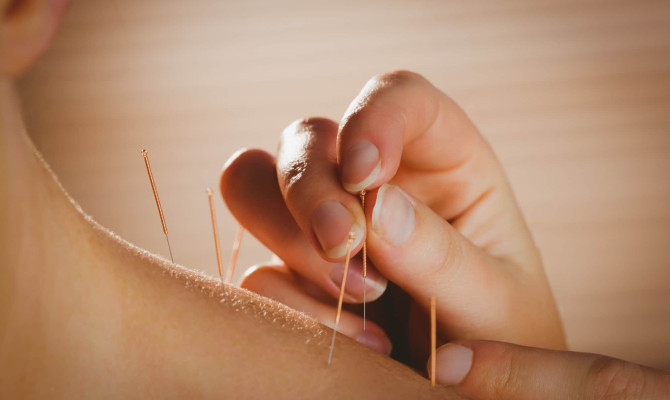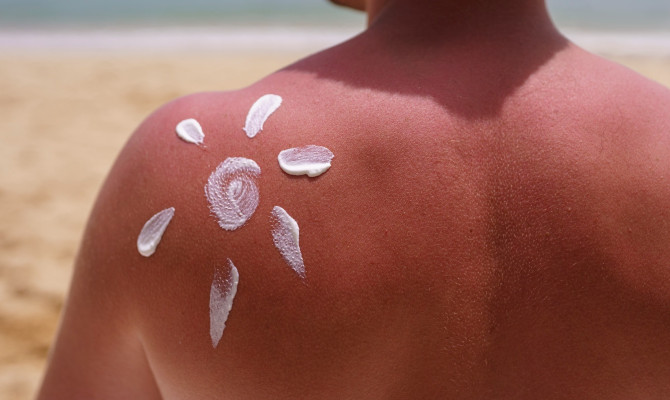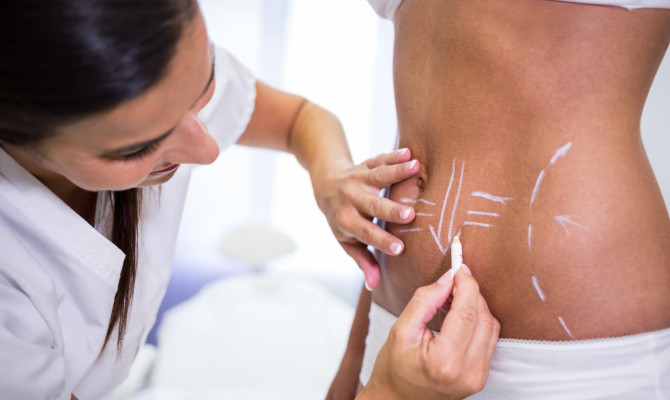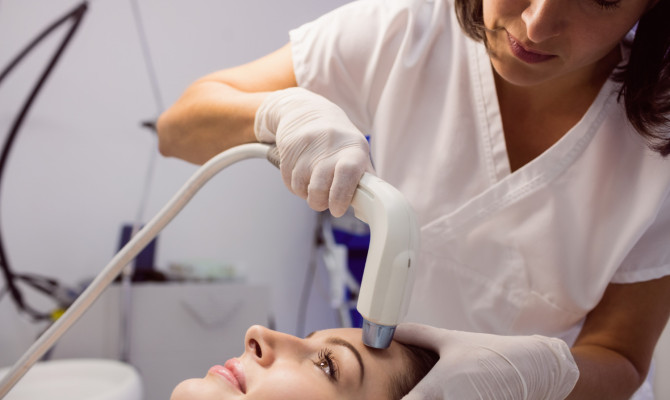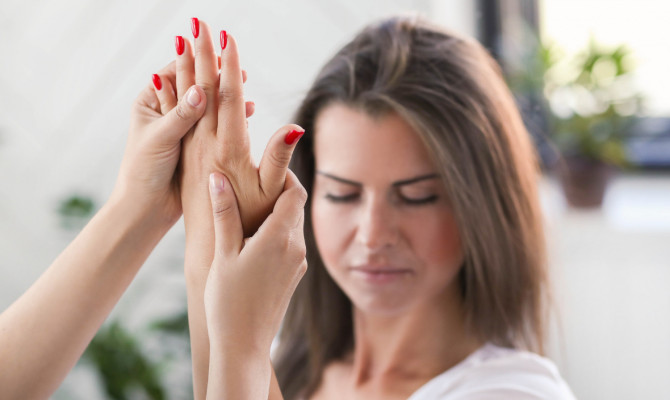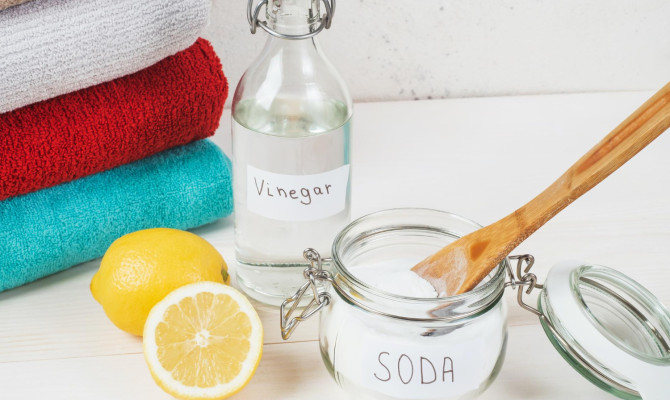Leg massage for Circulation: Benefits, Techniques & A Complete Overview

- Massage
- 07 Sep 2023
Overview
How does Blood Circulation work?
You might have heard that regular massage sessions will help in increasing blood flow, but don’t our bodies already have that ability? Although blood flow via our veins occurs naturally- but- poor, limited, or slow circulation causes health issues.

The circulatory system is responsible for pumping blood throughout the body and filtering out harmful substances before they reach the body’s vital organs. There are two parts to the circulatory system that help purify and oxygenate the blood:
Cardiovascular system:
- Blood and its primary transportation organs—the heart, arteries, veins, and capillaries—make up the cardiovascular system.
Lymphatic system:
- The lymphatic system is a collection of organs and tissues responsible for transporting lymph fluid throughout the body’s circulatory system and eliminating waste products.
- Lymph fluid collection beneath the skin is a common cause of swelling, and massage may help drain this fluid and redirect it to other areas of the body.
When one of these systems is disrupted, blood flow is also affected, putting additional strain on the heart.
Introduction
Leg Massage for Circulation?
Massage of the lower extremities, with the aim of increasing blood flow and enhancing circulation, is a well-established therapeutic practice. Leg massage is performed with the intention of improving blood circulation, which in turn increases the transport of oxygen and nutrients to cells and the elimination of waste products. It may be particularly helpful for those people whose circulation is compromised due to inactivity, illness, or injury. Leg discomfort, leg cramps, and other issues relating to the legs often respond well to a relaxing massage. You may decompress and chill down after a stressful day by just getting a leg massage.
Why a Leg Massage?
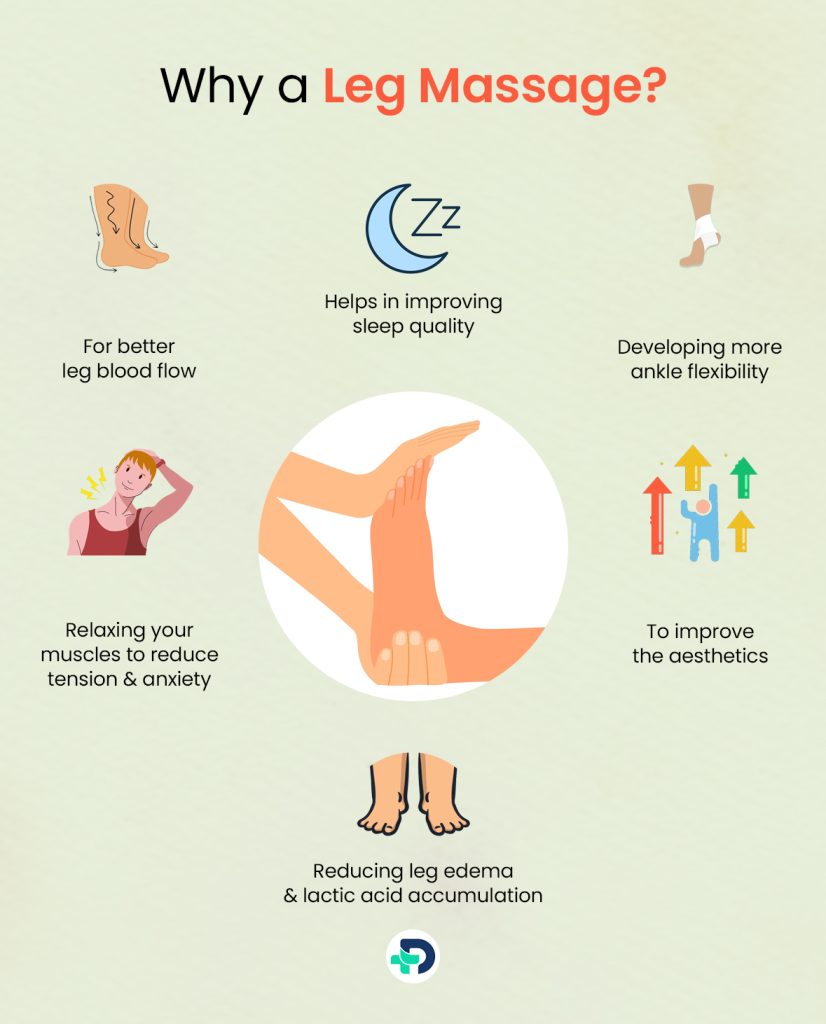
Why a Leg Massage?
A leg massage is performed on a person for the following reasons:
- For better leg blood flow
- Developing more ankle flexibility
- Reducing leg edema and lactic acid accumulation
- Letting your legs rest after you’ve been on your feet all day (or in a chair)
- Relaxing your muscles to reduce tension and anxiety
- To improve the aesthetics, comfort, and odor of your lower extremities
- Helps in improving sleep quality by keeping the legs toasty
Does leg massage improve blood flow?
- Even if your body is good at controlling your circulation on its own, getting a massage may help increase blood flow to your extremities.
- University of Chicago researchers 1 Reasons| Researched based study from University of Illinois Chicago verified in 2014 that massage performed after exercise enhanced circulation and decreased muscular pain.
- Multiple physical and mental health advantages, including enhanced circulation, have been linked to massage therapy.
How does a leg massage improve leg circulation?
- Better blood circulation is the result of increased blood flow to the legs, which in turn washes away the body’s accumulated toxins.
- When you give yourself a leg massage, you work the muscles in your legs. This method is useful for enhancing blood flow to the legs.
- When blood flow is enhanced in the legs, it naturally spreads to the rest of the body.
- Leg flexibility may be increased with regular massage. You’ll be able to run, jog, stroll, and climb stairs with more ease after doing this.
What massage is best for leg circulation?
- A simple leg massage is the best way to improve blood flow in the legs.
- This makes the area’s blood flow faster and can even help people with varicose veins.
- This type of leg massage is done by rubbing up from the ankle towards the lymph nodes present at the groin and behind the knee.
Techniques
Best Leg Massage Techniques to Improve Circulation
Here are some unique leg massage methods 2 Techniques | Researched based study from National Institutes of Health that can help improve circulation:
Effleurage:
- Start with soft, long strokes that glide from the foot to the thigh.
- As you move up, apply slightly more pressure to help the blood flow toward the heart.
- Do this movement several times to frame up the muscles and get them prepared for more advanced moves.
Petrissage:
- Use your hands, fingers, and thumbs to knead the muscles.
- Lift and squeeze the muscles gently, then let go to let fresh blood come in.
- Pay attention to bigger muscle groups like the legs and calves.
- Move in circles and slowly put more pressure on the person if they are comfortable.
Friction:
- Use your fingers or knuckles to apply greater pressure in small circles.
- Pay attention to places where there is strain, knots, or tightness.
- Adhesions may be broken up and localized blood flow improved with this method.
Tapotement:
- Lightly tap or drum on the leg with your cupped hands or the sides of your arms.
- Start slowly and build up the pressure over time, but always pay attention to how comfortable the person is.
- Tapotement can get the blood flowing and wake up the muscles.
Ankle Pumps:
- Hold the person’s ankle with one hand and slowly bend and straighten the foot with the other hand.
- This movement helps blood move from behind the lower leg to the heart.
- Do this movement a few times to get more blood to the lower leg.
Leg Squeezes:
- Put both hands on the leg muscle and squeeze.
- Gently squeeze and let go, moving your hands from the ankle to just below the knee.
- This works like a muscle pump and helps the blood flow.
Lymphatic drainage:
- Use light, regular strokes to move lymph fluid slowly toward lymph nodes.
- Start with the feet and gradually move towards the hips.
- This method helps reduce swelling and improves the flow of water.
Stretching:
- Gently stretch your leg muscles by moving your foot and ankle in and out.
- You can also do inactive stretches, such as bringing your leg gently to your chest.
- Stretching makes you more flexible and can help your blood flow.
Self – Leg Massage Techniques:
Here are a few ways of self-massage techniques for legs:
Wringing And Kneading
- Kneading increases soft tissue warmth, blood circulation, adhesion breakdown, and tone to reduce muscular tension. Kneading raises skin warmth. As temperature rises, muscle fibers relax, enabling greater mobility.
- Kneading pressures knots and adhesions, reducing tightness. Kneading restores fiber alignment, breaking knots and adhesions.
Chop Or Percussion
- Thighs and buttocks are beaten and pounded. This message uses loosely clenched hands to hit major muscles. Beating and hammering have a deeper impact than other percussion methods.
- Beating and hammering enhance blood circulation, remove fatty tissue, and tone muscles.
Stroking moves
- Swedish massage improves circulation and relaxes muscles using these techniques.
- There are 6 massage strokes and methods. These movements relax and enhance blood flow. This accelerates healing and relaxation.
Ball Or Foam Roller
- Finally, foam rolling improves circulation and releases muscular knots.
Benefits
Benefits of Leg Massage
Here are a few Leg massages for circulation benefits 3 Benefits | Researched based study from National Institutes of Health :
Better Blood Flow:
- The main goal of a leg massage circulation is to get the blood moving.
- With better circulation, oxygen-rich blood gets to all parts of the legs, giving cells the nutrients, they need.
Less swelling:
- Lymphatic drainage and light compression are two massage methods that can help reduce fluid buildup and swelling in the legs.
- This is highly helpful for people who have edema or swelling.
To get rid of muscle tension:
- Massage helps get rid of muscle knots and stress, which can stop blood from flowing.
- By letting tight muscles rest, blood vessels can open up better, letting blood move more easily.
Getting rid of pain:
- People who have bad circulation often feel pain or soreness in their legs. Massage can help relieve muscle pain and soreness, which can make you feel more at ease and calm.
Better flexibility:
- Light stretching methods that are part of the massage practice can make the leg muscles more flexible.
- This makes it easier to move around in daily life and lowers the risk of muscle pain.
Comfort and warmth:
- Because massage stimulates blood flow, which provides the muscles with more oxygen and nourishment, it might make your legs feel warmer.
- For those who suffer from chilly or numb legs, this might be rather comforting.
To get rid of stress:
- Endorphins are biological feel-happy” hormones that are released when you get a massage.
- This can make people feel less stressed and anxious, which can help them feel more relaxed overall.
For healthier skin:
- When circulation is better, skin cells get more nutrients, which makes the skin healthier.
- Also, rubbing the skin with oils or lotions can help keep it moist and make it smoother and softer.
Better function of the lymphatic system:
- Lymphatic drainage is a technique that can boost the lymphatic system and help the body get rid of toxins and waste.
Manage circulatory problems:
- Increased blood flow can help people who have peripheral artery disease (PAD) or varicose veins.
- A leg massage can help relieve symptoms and make these conditions easier to deal with.
Better mood and less stress:
- In addition to the physical effects, a leg massage can also be good for your mental health.
- Massage can make you feel calmer and happier because it makes you feel more relaxed.
Healthy vein function:
- A leg massage can help veins work well and lower the risk of blood clots and other circulation problems by getting the blood to flow toward the heart.
How can you achieve the most out of a leg massage?
- Stretching exercises are one of the best ways of leg massage and it helps the blood flow in your legs.
- When you stretch your muscles, you make them more flexible and give them a wider range of motion. This makes better circulation.
- It is one of the best ways to make your legs’ blood flow better. To get the most out of it, stretch your legs, hamstrings, shins, quads, glutes, groin, and hip flexors.
Do leg massagers help nerve pain?
- Leg massagers can help with neuropathy symptoms like stiffness, tingling, and pain for a short time.
- They can help get blood flowing, rest muscles, and maybe even relieve pain. Just make sure to talk to your doctor first to see if leg massagers are right for your situation.
Tips
Tips for Leg Massage
Do it regularly:
- Like everything else, giving your legs a massage regularly will give you the best benefits. Do it each day.
Pay special attention to your calves and thighs:
- You can massage your whole leg, but you should pay special attention to your calves and thighs because they carry most of your weight.
Use good oil or lotion:
- It is important to use good oil or lotion when rubbing your legs.
- This will help you relax, improve your blood flow, and get rid of the lactic acid that has built up in your legs.
Wear clothes that are loose and comfortable:
- When massaging your legs, make sure you are wearing clothes that are loose and comfortable.
- Doing so will improve blood flow and relieve muscle tension simultaneously.
Take breaks often:
- You should stop getting a massage every so often so you don’t get too tired. This will make it easier for you to unwind.
Is it okay to massage legs daily?
- Yes, giving your legs a massage, every day can be good for you.
- A gentle massage for a few minutes a day can help improve blood flow, ease muscle tightness, and help you rest your legs.
What happens if I massage my legs every day?
- A daily 10-to-20-minute leg massage can be very helpful because it can relieve stress and tightness and keep your leg muscles in good shape.
- It also gets the blood moving and makes the circulation better in that area.
Contraindications
Who should not get a Leg Massage?
Some health problems may keep you from getting a massage 4 Contraindications | Researched based study from University of Minnesota , either because the massage will make your symptoms worse or because it will hurt. If you have any questions or worries about getting a massage or giving yourself one, you should talk to your doctor.
If you have any of the following, don’t book or give yourself a massage for circulation:
- You have blood clots (Deep vein thrombosis).
- You may be pregnant (unless you’re getting a professional prenatal massage).
- You are more likely to get bruises because you take blood thinners or have a low platelet count.
- You have a fever or a disease that can spread.
- Your bones are weak because you have serious osteoporosis.
- You have a rash, spots that are open, or skin that is breaking down.
- You have swollen veins that hurt.
- You have a lot of mass in your arms, legs, or face.
- You are having a flare-up of a skin condition caused by an autoimmune disease (unless you are working with a masseuse who knows how to treat autoimmune symptoms).
- You are feeling weakness in your limbs, which is a sign of diabetes.
Essential Oils
Essential Oils to enhance Leg Massage
During a leg massage, there are a few essential oils that are thought to have qualities that may help improve circulation and relieve pain.
You should always consult a doctor before using essential oils, particularly if you are on medication or have a medical condition. Here are some essential oils that are often used to improve blood flow:
Oil of peppermint:
- Peppermint oil has a chemical called menthol in it that can cool and wake up the skin.
- It might help get the blood moving and make you feel like your circulation is better.
Ginger Oil:
- Ginger oil is known to make one feel warmer. It might help open up blood arteries and make the flow of blood better.
- Ginger oil can be very strong, so it must only be used in tiny amounts and dissolved properly.
Oil of Rosemary:
- Rosemary oil may help improve blood flow when put on the skin because it is thought to have exciting and warming benefits.
- Before you use rosemary oil, it’s important to blend it the right way.
Oil from cypress:
- People often use cypress oil to improve circulation and get rid of fluid buildup.
- It might also help lessen the feeling that your legs are too heavy.
Lemon Oil:
- People think that lemon oil can help clean the blood and might help improve blood flow.
- Its cheerful smell could also help a leg massage feel more relaxed.
Black Pepper Oil:
- When used for a leg massage, black pepper oil might help get more blood moving because it is hot and exciting.
Remember these things when you use essential oils for massage:
Dilute it:
- Essential oils are very strong, so they need to be watered down before they can be used on the skin.
- Most of the time, a carrier oil (like jojoba, sweet almond, or coconut oil) is mixed with about 1% to 2% essential oil.
The Patch Test:
- Before putting any essential oil on a bigger area of skin, do a patch test first.
- Apply a small amount of oil that has been diluted to a small area and wait 24 hours to see if there are any bad effects.
Massage Techniques:
- Using the right massage methods can also help the blood flow. Using light strokes that go up toward the heart can help get the blood moving.
Remember that each individual responds to essential oils differently, so what works for one person may not work for another. Changes to your lifestyle, like regular exercise, a healthy diet, and staying hydrated, can be more successful in the long run if you want to improve your circulation.
Can you reverse poor circulation in legs?
- The bad blood circulation to legs won’t get better on its own if you don’t do anything about it. It could even get worse.
- But you can deal with and improve your poor circulation by making changes to your lifestyle, taking medicine, and, if necessary, having surgery.
Takeaway
Leg Massage will help
Heavy, aching legs are often the result of poor circulation. Edema and similar conditions may amplify this sensation and lead to further complications. Throughout the day, the body faces increasing difficulty in overcoming gravity as blood struggles to return to the heart. Compression socks and a good leg massage are the simple solution to this problem.
Any feedback on this article?
 This Articles content was accurate
This Articles content was accurate Very Informative Article
Very Informative Article I have a question or a comment
I have a question or a comment
 This article contains inaccurate content
This article contains inaccurate content This article was not helpful
This article was not helpful I have a question or a comment
I have a question or a comment
We appreciate your helpful feedback!
Checkout our social pages
References
-
University of Illinois Chicago
1. Reasons
-
National Institutes of Health
2. Techniques
-
National Institutes of Health
3. Benefits
-
University of Minnesota
4. Contraindications












